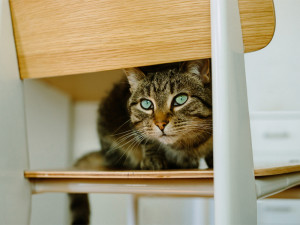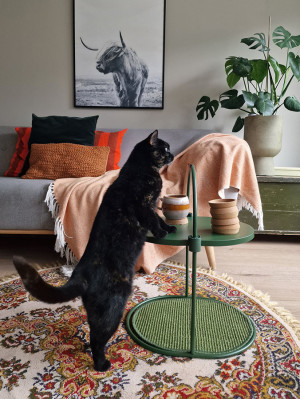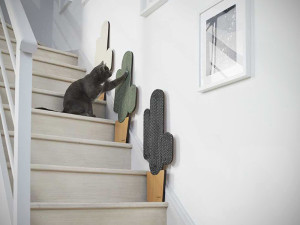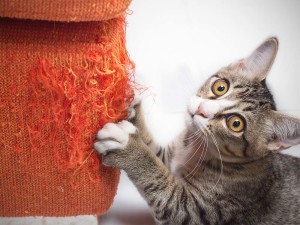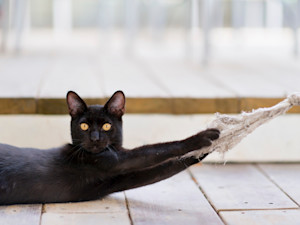
Share Article
In This Article:
Why Does My Cat Randomly Scratch the Wall? Specific Cat Wall Scratching Scenarios How to Stop a Cat from Scratching the Walls Frequently Asked Questions
When we think of the destructive scratching that cats do, we often picture a couch that has been methodically destroyed or curtains hanging in shreds. But cats can scratch a lot of other surfaces in your home, including wooden fixtures (such as stair banisters) and even walls. The behavior of cats scratching walls stems from several natural instincts, including the need to mark territory, stretch muscles, and maintain claw health. While this habit is frustrating, understanding the motivations behind wall-scratching is crucial for addressing the behavior effectively.
Why does my cat randomly scratch the wall?
Why would a cat scratch a wall, of all things in the house? To determine what might be so special about walls (to some cats), it’s beneficial to take a look at why cats scratchopens in new tab things in general. And it’s not all about “sharpening their claws.” There are several reasons for why cats scratch things, including the following:
Territorial marking
Cats are territorial animals. To help them define their territory and the objects within, they will often put their own scent on various items to let other cats know that they’ve been there, or that something is “owned” by that cat. Sometimes this happens with urine or feces (if done with poop, it’s called “middening”), but scratching is another way to leave a scent mark behind.

Cats’ paw pads have scent glands that leave a pheromone behind when scratching, called Feline Interdigital Semiochemicalopens in new tab (FIS), and FIS can be a way to tell other cats about territory ownership. Scratching also leaves a visual mark, too — another way to claim territory. You’ll often find cats scratching things along commonly traveled pathways and entrances or exits to areas in homes.
Claw maintenance
Claws are important tools for cats, and it’s important that they be in tip-top condition if they’re going to be the adorable little killing machines that they were born to be. Scratching keeps claws in good shape by removing the dull outer sheath of the nail, leaving the sharp strong nail underneath exposed. Now, the cat is prepared to both defend themselves and hunt their prey with four paws worth of razor-like weaponry.
Attention-seeking behavior
How do you react when your cat scratches something they shouldn’t? We often stop what we’re doing and turn our attention immediately to the cat and tell them no. And if your cat is looking for attention, they’ve just won it… and they’ve trained you to give them attention on demand.
Even when we give them attention that isn’t play or food-related, when our cats are looking for some interaction with their humans, coming up with something naughty will do. You may find that your cat runs away after being caught in the act of scratching, which could be your kitty’s way of saying that they want an interactive play session. You know what they say about idle paws being the devil’s workshop, right? Well, a bored cat has the potential to put those paws to use in ways that you might not find all that amusing.
Stress-related scratching
You might have an anxious cat. Scratching can also be what’s known as a displacement behavioropens in new tab, which is an out-of-context activity that a cat displays in response to stress or anxiety. For example, if there is conflict between two cats in a home, one cat may suddenly turn to grooming or scratching if a negative interaction between the cats occurs. This is a way to alleviate some of that in-the-moment stress and energy.
Pain or medical issues
Finally, scratching could be an a response to pain or medical conditions that the cat is experiencing, which may or may not be related to the paws. When a cat is not feeling well, that can elevate stress, which can result in scratching. Additionally, if your cat is experiencing discomfort with their paws or claws, scratching may be an attempt to alleviate that sensation. In these cases, a trip to your vet is always advisable.
Specific cat wall scratching scenarios
Now that we understand scratching behavior a little bit better, we can dive more into the question of why your cat keeps scratching the walls specifically. It might seem random, but if you look at exactly what your cat is doing, you’ll uncover some important clues.
Why does my cat scratch the corner of the wall?
Corners of walls often occur along well-traveled pathways in the home, and that makes them a perfect target for scratching and leaving those FIS scents behind as a way to mark the location.
Why does my cat scratch the wall after eating?
Cats are not only predatory beasties, but small cats are also prey animals in the wild. They don’t want to leave things around that will one, draw in other predators and alert them to their presence, or two, draw in competitors to take the food that they have cached.
It’s worth an attempt to bury food after eating so that it becomes less noticeable by sight or smell. If you keep your cat’s food bowls close to the wall, you may see your cat pawing and scratching at the floor and walls nearby in an attempt to cover their food.
My cat scratches the wall after pooping
Is your cat’s litter box too small or right next to the wall? Cats instinctively bury their waste — both pee and poop — to hide their presence from other predators who might be in the area. If your litter box is too small, they might not have enough room to scratch in the litter box itself, and you’ll see them scratching the floor and wall instead.
My cat scratches the walls at night
There are a couple of reasons why your cat might scratch the walls at night. First, cats can be quite active at night, prowling around the house and surveying their territory, and as explained, scratching can be part of marking their territory. Next, your cat could be bored, and scratching the wall might be a sure-fire way to get your attention. Finally — and be honest — have you punished your cat for scratching something that’s off-limits? If so, your cat may have learned simply to scratch when you’re not around (or asleep).
How to stop a cat from scratching the walls
Now that we know why your cat is scratching the walls, we can address the issue. Your cat is simply trying to meet an instinctual need, so instead of saying “no,” let’s start to say “yes.”
Redirecting behavior
Make sure that you are providing your cat with adequate scratching surfaces that they ARE allowed to scratch (and they don’t even have to be ugly!). If your cat is scratching walls, they may prefer a tall, sturdy, vertically-oriented wooden scratching post. Cats have varying preferencesopens in new tab for the type of scratchers they like, so let your cat’s behavior tell you what they might preferopens in new tab. Further, it can help to sprinkle a little catnip or silver vine on the scratchers you provide.
Using deterrents on walls
There are a few products out there that can both protect your walls and make them less attractive to a would-be scratching cat. Double-sided sticky tape is one option, and self-adhesive clear plastic panels are another. You can use these as training aids initially, then remove them once your cat knows where they’re supposed to scratch.
Creating a cat-friendly environment
Where you place your scratchers is just as important as what kind of scratcher you use. Don’t place scratchers in the corners of the room or in out-of-the-way locations. Instead, put scratchers right next to the spot that they’re currently scratching — that’s a spot that they are interested in marking. This will let your cat mark their territory in a way that works for them!
Positive reinforcement
When you see your cat using the scratcher that you’ve provided, be sure to reinforce that behavior by doing something your cat likes — this could be giving them praise, petting, a treat, or even a little bit of playtime. Additionally, don’t pick up you cat and put their paws on the scratcher; this can form a negative association with the scratcher, which will backfire when you want them to use the scratcher on their own.
Clicker training
Using a clicker is a great way to mark appropriate scratching right when it’s happening! Then, you can follow that click sound with a treat (or some other reward) so that your cat understands that using the scratcher results in good things for them. It’s another way that positive reinforcement really pays off when it comes to teaching cats about alternative acceptable ways to express instinctual behaviors.
FAQs:
How to stop your cat from scratching your couch?
You can stop your cat from scratching your couch by placing an appropriate scratching post right next to the couch and rewarding your cat when they use it. It may also help to place double-sided sticky tape on the part of the couch your cat is scratching, in conjunction with providing a scratcher your cat loves.
How to cat-proof your house?
To cat-proof your home, secure breakable objects, cover your electric cords and cables, secure your windows, and get rid of plants that may be toxic to kitties, in addition to a few other actions you can take to keep your cats safe.
References:
“Displacement Activities and Stereotypes - Cats International.” Catsinternational.org, 2019, catsinternational.org/displacement-activities-and-stereotypes/.
“Feline Behavior Problems: Destructive Behavior.” Cornell University College of Veterinary Medicine, 9 Oct. 2017, www.vet.cornell.edu/departments-centers-and-institutes/cornell-feline-health-center/health-information/feline-health-topics/feline-behavior-problems-destructive-behavior.
DePorter, Theresa L, and Ashley L Elzerman. “Common Feline Problem Behaviors: Destructive Scratching.” Journal of Feline Medicine and Surgery, vol. 21, no. 3, 25 Feb. 2019, pp. 235–243, journals.sagepub.com/doi/full/10.1177/1098612X19831205, https://doi.org/10.1177/1098612x19831205.
Vitale, Kristyn R. “Tools for Managing Feline Problem Behaviors: Pheromone Therapy.” Journal of Feline Medicine and Surgery, vol. 20, no. 11, 30 Oct. 2018, pp. 1024–1032, journals.sagepub.com/doi/pdf/10.1177/1098612X18806759, https://doi.org/10.1177/1098612x18806759.
Zhang, Lingna, and John J. McGlone. “Scratcher Preferences of Adult In-Home Cats and Effects of Olfactory Supplements on Cat Scratching.” Applied Animal Behaviour Science, vol. 227, June 2020, p. 104997, https://doi.org/10.1016/j.applanim.2020.104997.

Marci Koski
Marci Koski fell in love with cats as a toddler and never looked back, even leaving a career as an endangered species biologist for the U.S. Fish and Wildlife Service to start her own cat behavior consulting service, Feline Behavior Solutions in 2014. Since then, Marci has been helping people resolve their cat behavior issues by teaching people “how to cat” — namely, how to give their cat the resources and environments they need to thrive with their human companions.
Marci has a PhD in Fishery and Wildlife Biology, and earned her specialized and advanced Feline Training and Behavior certifications through the Animal Behavior Institute.
Related articles
![Grey cat sitting on on stairs scratching at the cactus shaped Meyou Paris Vegas Scratcher]()
The Best Cat Scratching Posts, Pads, and Everything in Between
Save your sofa.
![Kitten scratching fabric sofa]()
How to Stop Your Cat From Absolutely Ripping Apart Your Couch
Placing a cat tree or post in a room only, uh, scratches the surface of solving this problem.
![A black cat holding onto a rope with its claws.]()
It’s Seriously Uncool to Declaw Your Cat
A cat veterinarian explains why the inhumane surgery is no joke.
![Woman lies on carpet with orange cat.]()
Best Carpet For Cats—Durable and Scratch-Proof Options
Options that won’t become a hiding place for those big, yucky wads of fur.
![Cat enjoying laying on girl's legs and being cuddled]()
New Research Aims to Reduce Cat Stress During Nail Trims
Plus, expert advice on how to trim your cat’s nails at home.
![Man holding his cat.]()
Your Cat’s Anxiety—Explained
Because they’re probably not going to tell you why they just scratched the heck out of the couch.

